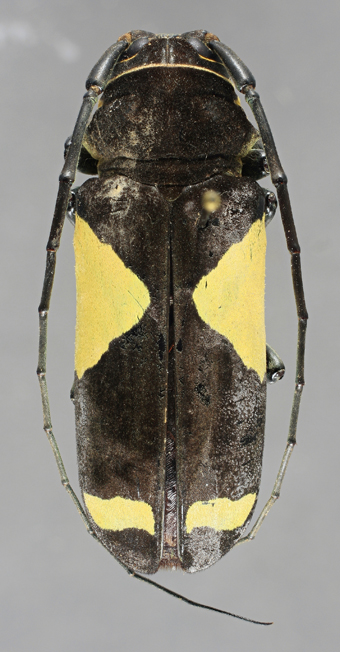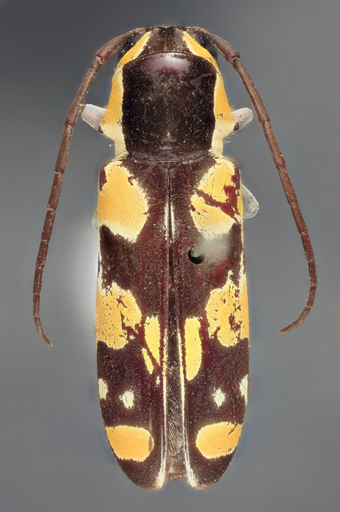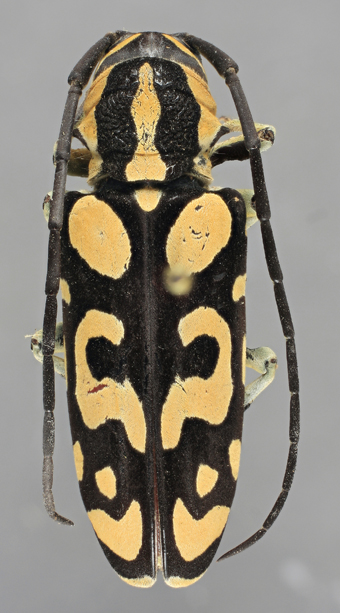 |
Tragocephalini
Classification
Introduction
- The tribe Tragocephalini Thomson, 1857 currently contains 270 species in 63 genera. Photographs of 3 exemplar specimens are currently available for this tribe.
Diagnostic Features of Adults
- Body small to moderate-sized, approximately 10-40 mm, rarely exceeding 40 mm in length; generally elongate; body without metallic reflection. Eyes generally reniform, complete (not completely divided into upper and lower lobes). Antennae filiform, unarmed; antennae long, generally extending beyond elytral apices by several segments. Head with or without distinct anterior projection. Pronotum shape variable, from approximately subquadrate (about as long as wide) to transverse (distinctly wider than long); lateral margins of pronotum variable, with or without distinct spines or blunt tubercles. Mesocoxal cavity open to mesepimeron. Wings generally complete. Legs with tarsal claws smooth; claws narrowly to moderately separated (divergent).
Diagnostic Features of Larvae
- Mature larva. Length up to 63 mm; maximum breadth (at prothorax) 9.5 mm. Head moderately depressed, slightly elongate, widest at middle (maximum head-width 4.9 mm) and rather abruptly and appreciably constricted on posterior third; frontal sutures complete but rather indistinct; antennal foramen open behind; mouthframe broadly and strongly sclerotized. Frons entirely ferruginous, smooth, with eight distinct setiferous pores; six epistomal setae present. Two pairs of distinct ocellar lenses present, the lower pair (situated opposite ventral articulation of mandible) slightly larger than upper pair and without a pigmented spot. Hypostoma slightly convex, ferruginous, front margin more darkly so; one pair of distinct setiferous pores present; sutures distinct, pitchy, incurved. Gular region with cleavage line indistinct. Antenna 3-segmented. Maxilla with palpal segment 3 acutely conical, shorter than segment 2. Labial palpi with segment 2 stoutly conical, about one-fourth Length of segment 1. Mentum distinct from submentum. Prothorax with pronotum faintly rugose, testaceous posteriorly and with a subapical transverse ferruginous band; sparsely setose, the setae mostly confined to sublateral areas. Abdomen with each dorsal ampulla with two transverse furrows and four transverse rows of subconical glabrous tubercles which are not interrupted medially; ventral ampullae with two rows of tubercles. Segments 8 and 9 strongly elongate, cylindrical, the latter unarmed. Anus trilobed, distinctly sclerotized, testaceous to ferruginous. Epipleurum protruding on segments 1-7 only. Pleural tubercle without sclerotized pits and bearing two stout setae. Legs minute, vestigial but just visible with a 15X lens. Spiracles with peritreme broadly oval, the posterior inner margin bearing a row of at least twenty subcontiguous chambers.
Pupa. Length 47 mm; maximum breadth 12.5 mm. Head with vertex entirely visible from above; vertex smooth, glabrous, not excavate between bases of antennae; frons with four to eight pairs of scattered minute spines; clypeus shallowly impressed with two to three pairs of similar spines. Antennae extending to abdominal segment 1, where they are strongly curved to form a single coil, the apices terminating near mid-femora. Eyes very strongly convex, glabrous. Mandibles each with a pair of setae near middle of outer face. Labrum cordate, rather strongly protuberant and bearing sub-basally two groups of about seven stout spines and margin bearing a few smaller spines. Pronotum with sides bearing a pair of large, stout tubercles; numerous short, stout spines present on disc and around tubercles. Mesonotum and metanotum bearing similar, much smaller scattered spines; scutellar groove indiscernible. Elytra and wings extending to abdominal segment 4. Abdomen with tergites 1-6 with a transverse band (interrupted medially) of closely set, short, stout spines (each tuberculate basally) on posterior half; anteriorly much less densely spinose. Tergite 7 with similar but scattered spines on posterior two-thirds. Tergite 8 strongly transverse, bearing similar spines. Tergite 9 produced posteriorly into a stout, acutely pointed, spine-like tubercle which is horizontal or slightly curved downward. Sternites glabrous. Pleura scarcely protuberant, each with about thirty short, stout spines (tuberculate basally). Legs with a transverse row of spinules near apex of each femur; middle and hind femora each with a blunt tubercular process near base; hind segment extending to abdominal segment 3; tibiae at right angles to longitudinal axis of body. Functional spiracles present on abdominal segments 1-6, those on segments 7 and 8 closed and probably non-functional; peritreme narrowly oval, thick and slightly raised above general level of cuticle; posterior margin with subcontiguous chambers. Adapted from Duffy (1957).
Geographic Distribution of Tribe
Biology and Economic Importance
- Biology unknown for members of this tribe. Species of this tribe are potentially invasive outside their native range.
Selected References to Adult Specimens
Selected References to Larvae Specimens
|  |

Phosphorus virescens
(Olivier, 1795); dorsal
Cerambycidae:Lamiinae:Tragocephalini
Photograph © E.H. Nearns

Tragocephala nobilis
(Fabricius, 1787); dorsal
holotype specimen
Cerambycidae:Lamiinae:Tragocephalini
Photograph © E.H. Nearns

Tragocephala variegata
Bertoloni, 1845; dorsal
Cerambycidae:Lamiinae:Tragocephalini
Photograph © E.H. Nearns
|




